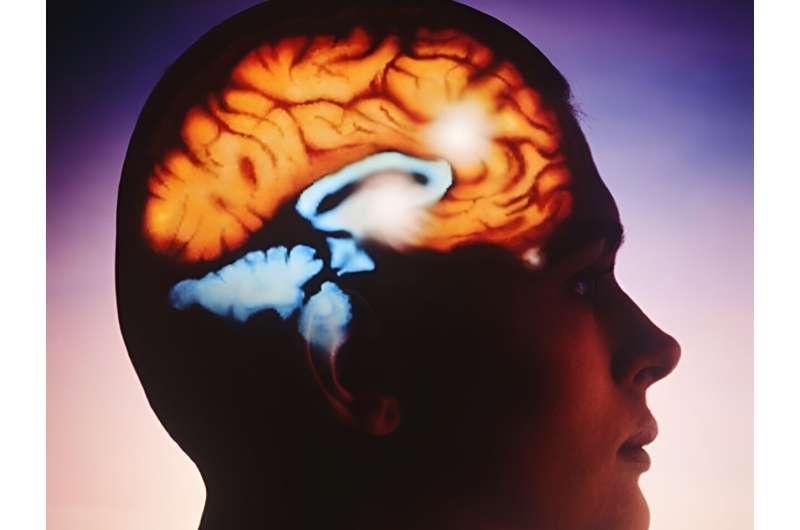This article has been reviewed according to Science X's editorial process and policies. Editors have highlighted the following attributes while ensuring the content's credibility:
fact-checked
peer-reviewed publication
reputable news agency
proofread
New brain target key to easing tough-to-treat epilepsy

Some people with tough-to-treat epilepsy might benefit if doctors target a brain region newly linked to the disorder, a new study suggests.
Seizures declined by 83% after a patient underwent surgery that removed almost all of the fasciola cinereum, a previously overlooked region of the hippocampus, researchers report April 17 in the journal Nature Medicine.
In practical terms, that means a patient who had been having one or two seizures a month now has one seizure every three months or so, results show.
The findings indicate that people with drug-resistant epilepsy might need the fasciola cinereum treated alongside other brain regions that are typically targeted, the researchers said.
"The hippocampus is the best studied part of the brain by far, but there is shockingly little known about the fasciola cinereum," said senior researcher Ivan Soltesz, a professor of neurosurgery and neurosciences at Stanford University School of Medicine.
The standard of care for epilepsy when drugs fail to work is surgery, researchers explained in background notes.
In one type, called mesial temporal lobe epilepsy, seizures originate in two specific brain regions: the amygdala, an almond-shaped structure involved in processing emotions, and the hippocampus, a region necessary for forming memories.
The brain is symmetrical, with an amygdala and a hippocampus on both the left and right side, and often seizures erupt from the structures on one side of the brain, researchers said.
So, doctors use electrode implants to figure out which regions are causing seizures, and then they remove those structures through surgery or by using a laser to burn them away, a process called ablation.
Because there's an amygdala and hippocampus on both sides of the brain, people still retain the ability to form memories following the procedure and typically have minimal side effects, researchers said.
But even this approach, as dire as it sounds, fails a third of the time, researchers said.
To figure out why, researchers started using electrodes to map in detail patients' brain seizure activity.
The hippocampus, located deep within each hemisphere of the brain near ear level, looks like a sea horse lying on its side with the head pointing toward the front of the brain, researchers said.
Electrode mapping of seizure activity noted that neurons in the fasciola cireneum—the far tip of the sea horse's tail—were active during seizures in mice.
Further, mouse studies indicated that if neuron activity in the fasciola cireneum were shut down, it shortened the duration of seizures in mice.
"Seizure activity in this region could be a reason why these surgeries sometimes fail," said co-lead researcher Dr. Ryan Jamiolkowski, a resident in neurosurgery at Stanford Medicine.
Researchers next turned to six human epilepsy patients, implanting electrodes to map seizure activity in their brains.
The fasciola cinereum contributed to the recorded seizures in all six patients, including some episodes in which the rest of the hippocampus remained silent.
One of the patients already had received laser treatment to burn away their amygdala and most of their hippocampus in the left brain, but nevertheless continued having seizures.
Electrode mapping showed that the only part of the hippocampus that remained, the fasciola cireneum, was involved in those seizures.
A follow-up laser procedure burned away the fasciola cireneum, and the patient's seizures declined by 83%.
Because of the way the hippocampus is shaped, future patients whose seizures involve the fasciola cireneum might need two separate surgeries as well, researchers said.
"The hippocampus curves like a banana, and the optical fiber used for laser ablation is a straight line," Jamiolkowski said in a Stanford news release.
To burn away the entire structure "requires different trajectories that are not currently feasible to combine into one procedure," Jamiolkowski explained.
The fasciola cireneum also might be targeted in patients with seizures emanating from the amygdala and hippocampus on both sides of their brains, researchers added.
To preserve their ability to form memories, these patients have a device implanted in the hippocampus that provides electrical jolts to interrupt a seizure before it can start rolling.
"Knowing which patients have seizures involving the fasciola cinereum would let us target it with either ablation or neurostimulation, and help us treat patients better than a one-size-fits all approach," Jamiolkowski said.
More information: Ryan M. Jamiolkowski et al, The fasciola cinereum of the hippocampal tail as an interventional target in epilepsy, Nature Medicine (2024). DOI: 10.1038/s41591-024-02924-9
© 2024 HealthDay. All rights reserved.



















